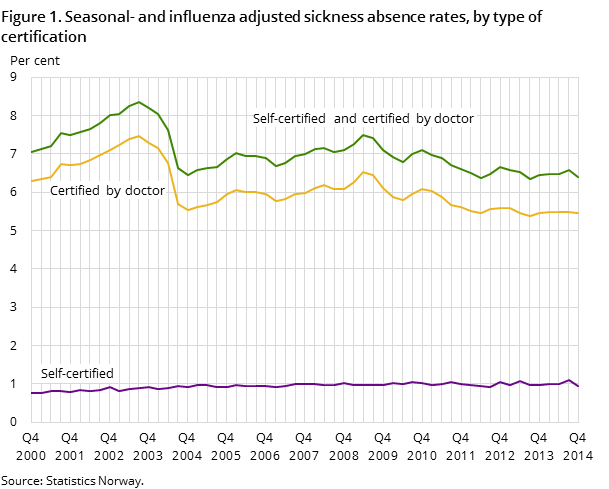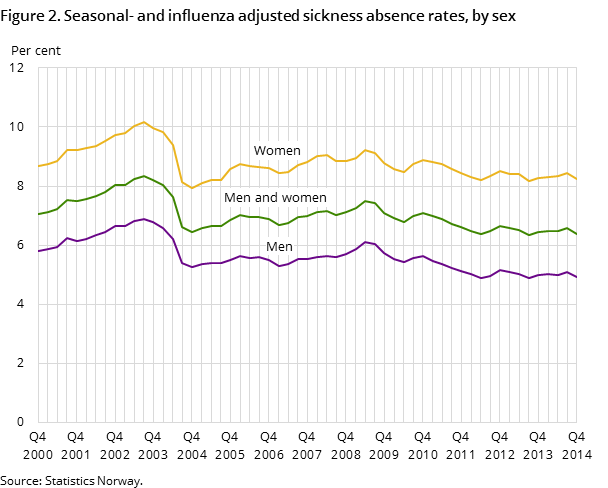Content
Published:
This is an archived release.
Stable seasonally-adjusted sickness absence
Sickness absence adjusted for seasonal and influenza variations was 6.4 per cent in the 4th quarter of 2014; a small decrease of 2.9 per cent from the previous quarter.
| 4th quarter 2014 | Per cent from previous quarter | |
|---|---|---|
| 1The sickness absence rates are shown to two decimal points. In other tables the rates are shown with one decimal point. More decimal points are used when calculating the rates of change in order to get more accurate figures. These will therefore differ slightly from the rates of change produced when using the published rounded figures. | ||
| Both sexes | ||
| Self-certified and certified by doctor | 6.39 | -2.9 |
| Self-certified | 0.94 | -13.6 |
| Certified by doctor | 5.45 | -0.8 |
| Males | ||
| Self-certified and certified by doctor | 4.92 | -3.2 |
| Self-certified | 0.83 | -11.5 |
| Certified by doctor | 4.09 | -1.3 |
| Females | ||
| Self-certified and certified by doctor | 8.22 | -2.5 |
| Self-certified | 1.06 | -15.5 |
| Certified by doctor | 7.16 | -0.2 |


Since 2012, the sickness absence rate has remained stable, with some small variations. The development from the 3rd to the 4th quarter of 2014 is in line with this pattern.
The reduction in sickness absence was mainly in the self-certified sickness absence, which decreased 13.6 per cent, while the doctor-certified absence remained more or less the same.
Sickness absence for both men and women decreased in the last quarter of 2014, with a 3.2 and 2.5 per cent drop respectively.
Since the 2nd quarter of 2001, when the agreement on an inclusive labour market (IA agreement) was first implemented, the seasonal and influenza-adjusted sickness absence has dropped 11.5 per cent.
Possible break in the statistics in 1st quarter 2015Open and readClose
NAV’s Employers and employees register, which has been one of the main sources for the calculation of the sickness absence rate, was replaced by a new register in January 2015. The new register, the A-ordningen, which serves NAV, the tax authorities and Statistics Norway, is likely to give a different figure for employees than the Employers and employees register. This is due to both a somewhat broader coverage of the group and the fact that the quality is expected to be better. The number of employees and their hours of work determine the denominator in the sickness absence rates. The sickness absence for the 1st quarter of 2015 is scheduled to be published on 18 June.
Contact
-
Arbeidsmarked og lønn
E-mail: arbeidsmarked@ssb.no
-
Unn H. Høydahl
E-mail: unnh.hoydahl@ssb.no
tel.: (+47) 40 90 23 77
